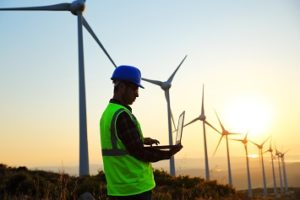According to the U.S. Bureau of Labor Statistics (BLS), the fastest-growing profession in the United States is wind turbine technician. We’ll take a look at wind turbine service technicians and the hazards inherent in such “green” jobs.
Wind Turbine Technicians
Wind turbine technicians, aka windtechs, inspect, diagnose, adjust, or repair wind turbines. They perform maintenance on wind turbine equipment, including resolving electrical, mechanical, and hydraulic malfunctions. Tasks include diagnosing problems involving wind turbine generators or control systems and climbing wind turbine towers to inspect, maintain, or repair equipment. The average wage nationally for wind turbine technicians in 2016 was $54,360 annually. The projected growth for this job through 2024 is 108%, which is considerably higher than average for all occupations.
The state with the highest employment for windtechs is Texas, followed by California, Iowa, Minnesota, and Illinois. The top-paying state is Pennsylvania (average $60,790 annually), followed by Iowa, North Dakota, South Dakota, and Oregon.
OSHA Takes On Green Jobs
The Occupational Safety and Health Administration (OSHA) defines “green jobs” broadly as jobs that help to improve the environment. These jobs also create opportunities to help revitalize the economy and get people back to work. However, green jobs do not necessarily mean that they are safe jobs. Workers in the green industries may face hazards that are commonly known in workplaces. These hazards may be new to many workers who are moving into fast-growing green industries. Additionally, workers may be exposed to new hazards that may not have been previously identified.
According to OSHA, workers in the wind energy industry face many common workplace hazards.
Falls
Wind turbines vary in height but can be over 100 feet (ft) high. Exposure to high winds may make work at high elevations even more hazardous. Construction workers on wind farms when exposed to fall distances of 6 ft or more must be protected from falls by either guardrails, safety nets, or personal fall arrests.
Maintenance workers on wind turbines fall under OSHA’s general industry standards. Such workers must be protected by a standard railing when exposed to fall hazards of 4 ft or more. If such a railing is not possible, the workers must be protected from falls through the use of personal protective equipment, such as a personal fall arrest system or a safety net.
In addition, maintenance workers on wind turbines may have to climb up the turbine towers using fixed ladders. While climbing a fixed ladder (exceeding 20 ft in length) on these towers, a ladder equipped with a cage or well must have a landing platform every 30 ft. A ladder not so equipped must have a landing platform every 20 ft. Ladder safety devices may be used on wind tower ladders over 20 ft in unbroken length in lieu of cage protection. No landing platform is required in these cases.
Fires
Wind turbines may have fire hazards because of the electrical parts and the combustible materials such as insulation or the material of construction used in the turbine housing (nacelle) or lubricants involved in its operation. A fire emergency plan should outline the assignments of key personnel in the event of a fire and provide an evacuation plan for workers on the wind turbines. Wind turbines should be provided with quick escape descent devices for workers to escape in the event of a fire or other emergency.
Tune in to tomorrow’s Advisor for other hazards windtechs face.

